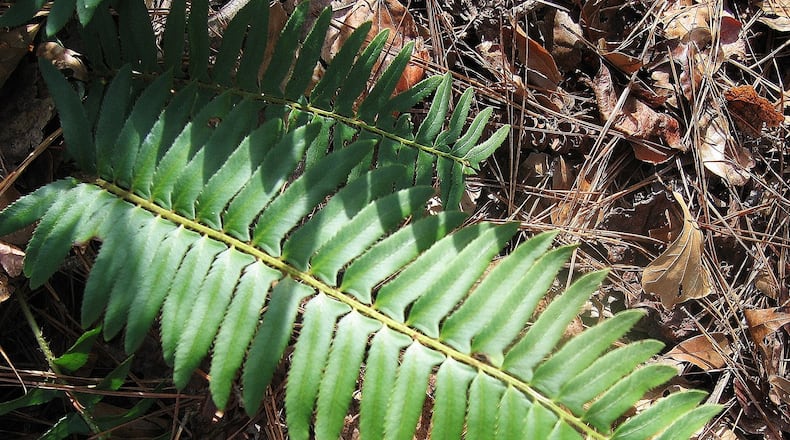This is the evergreen time of year, when those trees, vines, shrubs and ferns that retain their green foliage all winter stand out in the otherwise brown, drab woods.
Some of Georgia’s native evergreens include pines, magnolias, hollies, rhododendron, mountain laurel, live oak, green brier, Eastern red cedar, wax myrtle and others. Many of them have long been used to decorate homes, churches and schools for the holidays — and some for Christmas trees and wreaths.
One of Georgia’s most common wild evergreens has been used so extensively for yuletide decoration that it is named for the season — the Christmas fern. It is especially popular in making holiday floral arrangements.
(Some also say the fern’s name is due to its frond leaflets, each of which looks like a winter sleigh or a stocking hung from a fireplace mantel.)
Holiday decorations aside, few other wild plants brighten up bare winter woods more than the abundant Christmas fern — one of the few ferns that stay green all year. None of our other evergreen ferns is larger, and none has such rich, glossy and gleaming green fronds.
“Full veined and lusty green it stands, of all the wintry woods the gem,” said botanist-poet Willard Nelson Clute of the Christmas fern.
Its fronds may be up to 30 inches long and four inches wide with each frond bearing 20-40 leaflets. The plant grows in clusters of two or three individuals and sometimes in large, extensive colonies. It’s especially abundant on shady, forested hillsides near streams.
The fronds’ chemical composition and texture make them unpalatable to deer and other browsers, which seldom eat the fern.
Another native evergreen fern, the ebony spleenwort, superficially resembles the Christmas fern, but it is much smaller and has a shiny, black stem.
IN THE SKY: From David Dundee, Tellus Science Museum astronomer: The annual Ursid meteor reaches a peak about 15 meteors per hour tonight in the eastern sky. Best viewing time is from about midnight until dawn.
The moon will be full tonight — the Snow Moon, as the Cherokee peoples called this month’s full moon. It’s also called the Long Night Moon. Mercury and brilliant-shining Venus are low in the east just before dawn. Mars is low in the southwest at dusk.
About the Author
Keep Reading
The Latest
Featured


